|
Report
from
Europe
Uncertainty in European market for Chinese plywood
European demand for hardwood plywood manufactured in
China has been patchy during the second half of 2013.
Various issues have contributed to uncertainty in this
market during the period. Freight rates have been very
volatile.
In August, China imposed a 6% VAT requirement on both
the costs incurred from ex-mill to FOB and on prepaid
freight. Wet weather in some parts of China during the
autumn months led to delays in eucalyptus and poplar
logging. This in turn contributed extra transport costs for
mills forced to source logs from a larger area. The wet
weather also meant longer veneer drying times,
contributing to delays in shipments of finished plywood.
The market has also continued to be affected by increased
concern for legality verification following EUTR
enforcement. European importers are concentrating
purchases on the larger Chinese mills better able to
provide legality documentation.
Efforts to replace tropical hardwood veneers from regions
perceived to be high risk on illegal logging have
continued. This is changing the mix of products now being
delivered to the European market. There has been a
gradual rise in European demand for dyed reconstituted
poplar-faced plywood despite some concerns about the
quality of glues, the durability and difficulty of achieving
a smooth finish with these products.
Those European buyers willing to pay more for a higher
quality alternative have been sourcing Chinese plywood
faced with an FSC or PEFC certified sapele or meranti
veneer and a non-certified poplar or eucalyptus core.
Overall supply of Chinese hardwood plywood grades for
the EU market has been quite well balanced with demand
in recent months. Total production has been reduced due
to log supply problems and in anticipation of slow demand
over the European winter months.
During the autumn, Chinese mills were requesting that
orders be placed well in advance of the Chinese New Year
holiday season in January. By early December, many mills
had already fully committed their production for the preholiday
period.
Monitoring price trends for Chinese hardwood plywood is
now complicated by the diversity of certified and
uncertified products being sold into the EU market
following implementation of EUTR.
However, overall FOB prices have tended to firm on the
back of reduced production and higher veneer and other
costs in China in recent months combined with consistent
ordering in the run-up to the holiday season. Some mills
are compromising on the quality of veneers and glues in
an effort to maintain stable prices.
Availability of Chinese plywood to European buyers is
expected to become more restricted and prices to firm
during the first quarter of 2014. This is due to the
combined effects of limited log supply and the Chinese
New Year holiday.
There is also likely to be increased diversion of product to
the United States following the US government¡®s decision
on 5 November to dismiss the on-going anti-dumping case
against Chinese plywood. As a result, previously
announced anti-dumping and countervailing duties of
73.04% on US imports of Chinese plywood which were
due to come into effect in November have not been
imposed.
Volatile freight rates encourages EC anti-trust probe
into shipping lines on Asian routes
Fluctuating freight rates have contributed to very volatile
CIF prices for Chinese plywood delivered into Europe. For
example, freight rates on the Shanghai-Rotterdam route
fell from US$2,800/40ft container in early September to as
low as US$1300/40ft container by the end of October ¨C a
decline equivalent to about US$30 per cu.m of delivered
plywood.
In November, shipping lines tried to force rates for a 40-
foot container back up to US$2700, but these prices were
short lived and rates had fallen back to US$2000 by mid-
December.
The freight rate volatility stems partly from the practice of
the large container shipping firms operating on the Asia-
Europe route to announce major price hikes on a regular
basis.
These announcements have been made roughly
simultaneously four times in the past year, most recently at
the start of December. On each occasion, the larger firms
have been undercut immediately by smaller container
companies and the price hikes have failed to stick.
The European Commission, citing concerns that some of
the larger firms may be informing each other in advance of
their price intentions and thus impeding competition on
Asia-Europe routes, launched formal anti-trust
proceedings against 14 shipping lines on 22 November
2013.
Revision of EU GSP to impact veneer and plywood
market
Amendments to the EU's Generalized System of
Preference (GSP) scheme are impacting on the EU's
market for veneer and plywood. Certain developing
counties outside of the EU needing economic assistance
are permitted reduced rates of duty under the GSP scheme.
For customs declarations after 1 January 2014, eightyseven
of these countries will no longer benefit from GSP
status.
Of particular significance for the veneer and plywood
trade, Malaysia, Gabon and Russia will lose their GSP
status on 1 January 2014.
EU import duties for both plywood and veneer products
from these countries will then increase from 3.5% to 7%.
Cameroon, Ghana and Ivory Coast will also lose their GSP
status in January 2014, but these countries have other trade
arrangements in place. Brazil will also lose its GSP status
although this will not change anything in the case of wood
products because it was already specifically excluded after
having achieved a sustained significant volume of trade to
the EU.
Countries retaining their GSP status under the reformed
scheme include Congo DRC, Liberia and Myanmar. China
also retains its GSP status but, as with Brazil, this
specifically excludes timber products under Chapter 44, so
effectively no change.
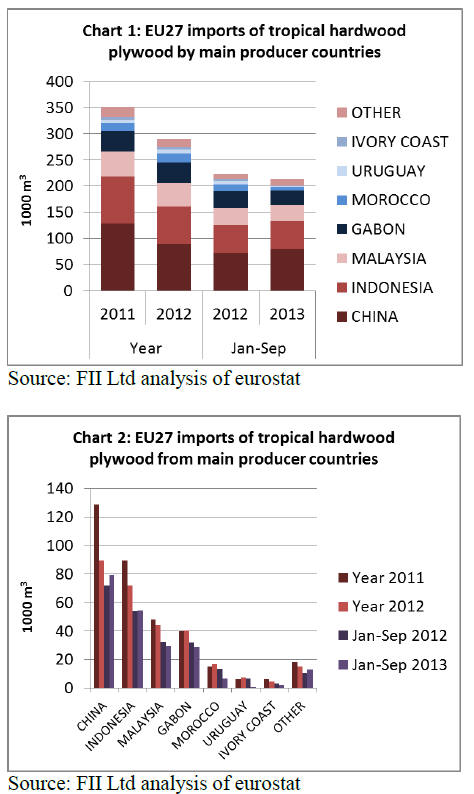
EU tropical plywood imports down 4% in first nine
months of 2013
EU imports of tropical hardwood plywood in the first nine
months of 2013 were 214,100 cu.m, 4.2% less than the
same period in 2012 (Chart 1). During the period, imports
increased from China by 10% to 79,000 cu.m and
remained stable from Indonesia at 54,000 cu.m.
However imports of tropical hardwood plywood fell by
8.4% to 29,700 cu.m from Malaysia, and by 9.2% to
28,900 cu.m from Gabon (Chart 2). Imports of tropical
hardwood plywood have been rising into Belgium, the UK
and France this year, but declining into the Netherlands,
Italy and Germany.
EU imports of plywood faced with other (non-tropical)
hardwoods have also been declining this year. Imports of
this commodity were 1.39 million cu.m in the first 9
months of 2013, 5.1% down on the same period in 2012
(Chart 3).
Imports from China during the January to September 2013
period were 632,600 cu.m, 10.8% less than in the first nine
months of 2012.
This decline was partly offset by a 5.3% rise in imports
from Russia to 517,000 cu.m (Chart 4). A slight rise in
imports by Germany, Poland, Italy and France was
insufficient to offset a decline in imports by the UK and
Belgium.
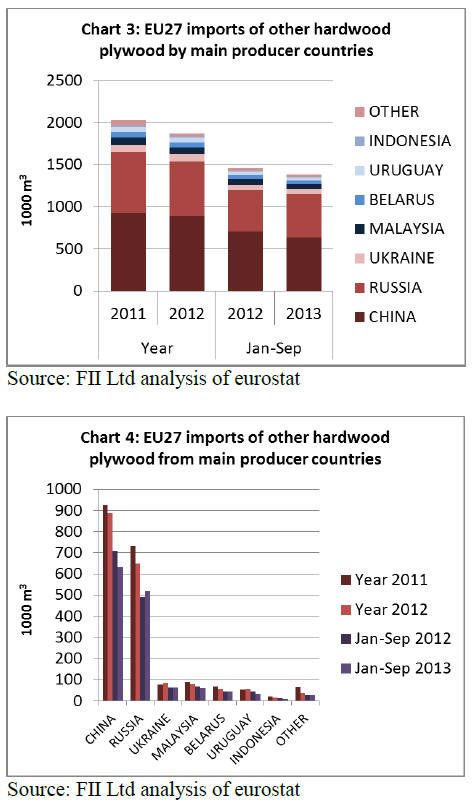
Slight upturn in European demand for Malaysian
plywood
While imports of Malaysian plywood into the EU declined
during the first nine months of 2013, recent reports
suggest a slight upturn in demand in the last quarter of the
year.
This is particularly true of the UK, Germany and Belgium.
Demand in the Netherlands and France has remained slow.
The short-term increase in demand has contributed to
lengthening delivery times for Malaysian plywood into
Europe. As for Chinese plywood, volatile container rates
have led to significant variations in CIF prices for
Malaysian plywood delivered to Europe in recent months.
However FOB prices have remained quite stable.
Prices for Malaysian plywood are typically up to one third
higher than prices for Chinese substitutes. However, there
is rising interest from importers seeking products
guaranteed to meet European technical performance
standards.
Enforcement of the EU Construction Products Regulation
(CPR) from 1 July 2013 means that CE-Marking
demonstrating conformance to the EN13986 standard is
now mandatory for all plywood used in structural
applications in the EU.
Importers have also been keen to beat the rise in import
duties on Malaysian plywood following the change in GSP
status on 1 January 2014.
European market for okoume plywood still very slow
Expectations that orders for okoume plywood
manufactured in Gabon might pick up in the second half
of 2013 in advance of the rise in import duties from 1
January 2014 have not been realised.
Demand for okoume plywood in Europe remains very
weak with slow buying in both the French and Dutch
construction sector.
There has also been little or no recovery in demand for
okoume plywood from the Italian boat manufacturing
sector this year. Margins in the European okoume
plywood manufacturing sector are extremely thin. In the
face of slow demand, French manufacturers have been
unable to raise selling prices.
Despite low demand, delivery times for okoume plywood
into the EU market have been increasing due to log supply
and transport problems in Gabon over the summer months
and a significant reduction in production both in Europe
and Gabon.
This is particularly true of FSC certified products for
which there is slightly firmer demand since
implementation of the EU Timber Regulation in March
2013.
Robust demand for Russian birch plywood
EU imports of Russian birch plywood have been higher
during 2013 than in 2012. This is despite widespread
reports of supply shortages due to limited log supply in
Russia and rising demand in Russia¡®s domestic market and
in Turkey, Asia, and in the Middle East.
This in turn has led to long lead times on new orders and
delays to existing orders. Delivery periods for rough
plywood now extend up to 2-3 months.
However availability of Russian film and mesh faced birch
plywood is better and delivery times are shorter. Russia's
exclusion from the EU's GSP on 1 January 2014 has
encouraged some increased buying in the last quarter of
2014 in anticipation of the rise in import duties.
China and Brazil increase share of EU softwood
plywood imports
EU imports of softwood plywood were 1.01 million cu.m
in the first 9 months of 2013, 3.6% down on the same
period in 2012 (Chart 5).
Imports from Brazil during the January to September 2013
period were 680,100 cu.m, 1.8% more than during the first
nine months of 2012.
Imports of softwood plywood from China also increased
during this period, by 10.2% to 123,100 cu.m. However,
imports from Chile declined by over 27% to 104,200 cu.m
(Chart 6).
A rise in softwood plywood imports by Germany, the UK,
and Belgium was insufficient to offset a larger decline in
imports by Italy, Denmark and the Netherlands.
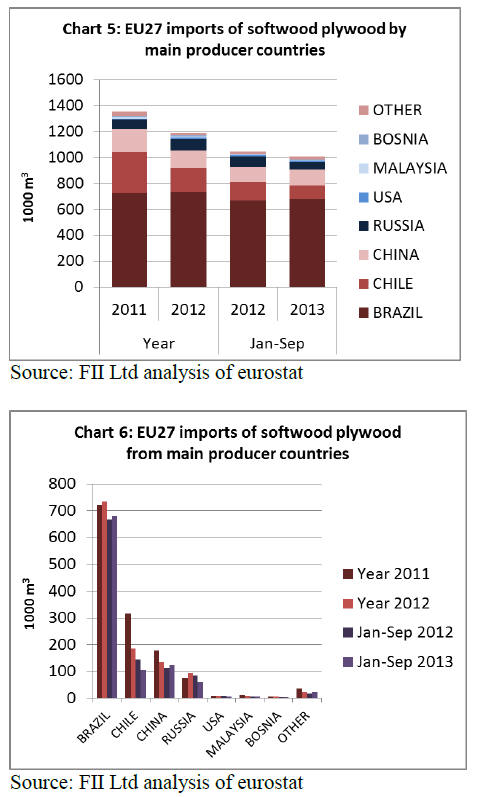
Prices for Brazilian elliotis pine plywood on offer to EU
importers have risen $10-15/cu.m in recent months,
mainly in response to good demand in Brazil and US,
Mexican and Caribbean markets and to rising freight costs.
Flooding in southern Brazil during September led to a
short-term increase in delivery times during the autumn
months.
Higher prices also led to reduced orders from some
European importers concerned about the difficulty of
passing on increased prices to customers at a time when
European consumption is still quite slow.
Nevertheless, there are reports of reasonable European
forward orders for delivery in January under the 2014
quota.
TTJ reports firm plywood demand in the UK
The UK Timber Trade Journal¡®s latest plywood market
report for the UK suggests that demand in the country is
now ¨Dfirm¡¬ and product from most sources is attracting
stable to rising prices.
Forward ordering is patchy, but consumption is reasonable
and there is rising optimism about the future. Most
importers are still mainly topping up stock, but more
regular monthly orders are now coming through. UK
importers expect that total sales in 2013 will be slightly
better than in 2012.
EU tropical hardwood veneer imports down 10%
EU imports of hardwood veneer have been declining this
year. Imports of tropical hardwood veneer in the first nine
months of 2013 were 180,800 cu.m, 10.2% less than the
same period in 2012 (Chart 7).
During the period, imports from Gabon fell 13% to 89,100
cu.m. Imports from Ivory Coast were down 9.5% at
42,700 cu.m. These losses were only partly offset by a rise
in imports from Cameroon, up 7.3% at 21,500 cu.m (Chart
8).
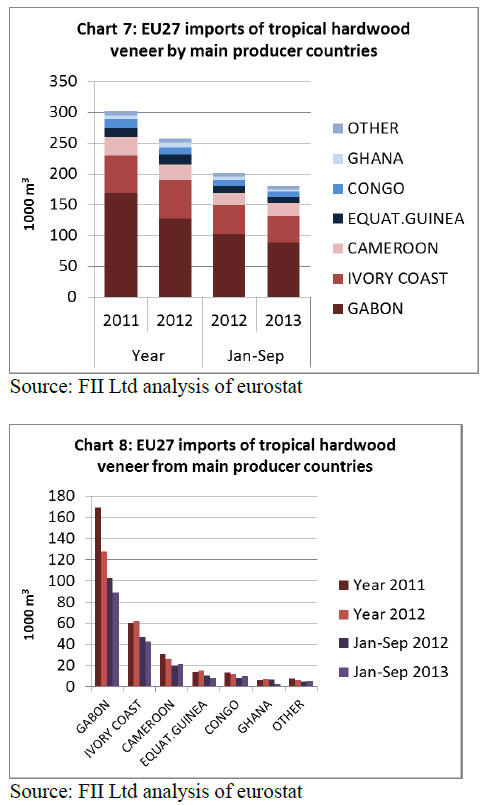
In the first nine months of 2013, imports of tropical
hardwood veneer into France declined 14.9% to 75,100
cu.m. Imports into Spain fell 12.1% to 24,100 cu.m.
However, after a very weak year in 2012, there was a
17.7% rise in imports by Italy in the first nine months of
2013 to 41,100 cu.m.
The decline in EU imports of tropical hardwood veneer is
partly due to weak demand in end-use sectors for
decorative sliced products. Sales to the European door and
furniture manufacturers have been weak all year. There
has also been only slow demand from large interiors
projects, such as hotel, shop and bank refurbishment.
While sales of sliced veneers to board manufacturers and
higher value speciality sectors, such as automobile and
yacht manufacturing have been more stable, these have
been insufficient to offset the decline in the larger
industrial sectors.
In fact rising sales to veneered board manufacturers may
be partly at the expense of direct sales of veneers to
joiners. Prices for sliced veneer are coming under intense
pressure in the European market.
The market situation is little better for rotary tropical
hardwood veneers used for plywood and flooring
manufacturing in Europe. Market conditions in the
European engineered wood flooring sector remain weak
and there is a continuing trend to substitute tropical woods
for alternative materials.
There is also limited demand for veneers in the European
okoume plywood manufacturing sector now that capacity
is much reduced, particularly following the closure of
France-based producer Plysorol in 2012.
EU imports of temperate hardwood veneer in the first nine
months of 2013 were 127,900 cu.m, 5.9% less than the
same period in 2012 (Chart 9). Due to recent inward
investment, Ukraine is becoming a more important
external supplier of hardwood veneer to the EU.
According to UNECE Timber Committee data, veneer
production in the Ukraine has been rising in recent years
and the country is exporting a wide range of sliced, rotary
and reconstituted (fine-line) veneers into the EU. During
the first nine months of 2013, imports from Ukraine were
31,100 cu.m, 4.7% up on the same period in 2012.
Meanwhile, EU imports of temperate hardwood veneer
fell from the USA by 4.3% to 29,200 cu.m and from
Russia by 9.2% to 20,400 cu.m (Chart 10). Temperate
hardwood veneer imports have been rising into Germany,
Austria and Poland this year, but falling into Italy and
Spain.
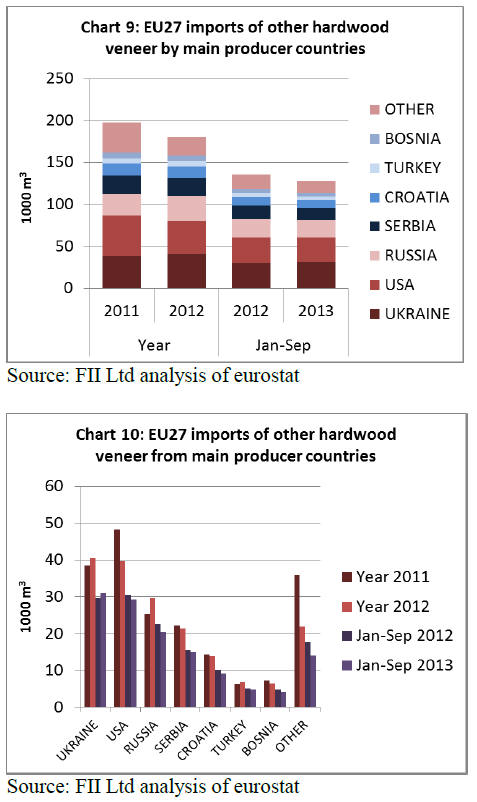
|